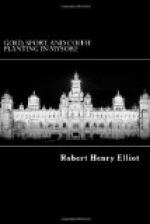FOOTNOTES:
[25] Printed for the use of the Government, and kindly lent to me by the Dewan of Mysore.
[26] Mr. Bosworth-Smith, vide p. 36 of his Report, says that, up to 1889, only three finds of iron tools had been met with in the old native workings.
[27] In Mr. Hyde Clarke’s paper entitled “Gold in India,” London, Effingham Wilson, Royal Exchange, 1881, it is stated that “Dr. Burnell brings direct proof as to the abundance of gold, by his successful decipherment of a remarkable inscription in the Tanjore temple. Dr. Burnell is thus enabled to state that in the eleventh century gold was still the most common precious metal in India, and stupendous quantities of it are mentioned. He considers, too, that this gold was obtained from mines, and that the Moslem invasion interrupted their workings.” It does not, however, appear, at least in Mr. Hyde Clarke’s paper, that the inscription deciphered by Dr. Burnell makes any reference to gold mining.
[28] “The Kolar Gold Field in the State of Mysore.” Reprinted from the “Madras Mail,” December, 1885; Madras, the Madras Mail Press. London, Messrs. H. S. King and Co., 1885.
[29] Those who desire detailed information are referred to Mr. P. Bosworth-Smith’s “Report on the Kolar Gold Field and its Southern Extension.” Madras, Government Press, 1889. Mr. Bosworth-Smith writes as Government Mineralogist to the Madras Presidency.
[30] “Selections from the Records of the Mysore Government. Reports on Auriferous Tracts in Mysore.” Bangalore. Printed at the Mysore Government Press, 1887.
CHAPTER VIII.
CASTE.
In Krilof’s fable of “The Peasant and the Horse,” the latter murmurs at the way his master throws oats broad-cast on the soil. “How much better,” argues the horse, “it would have been to have kept them in his granary, or even to have given them to me to eat!” But the oats grow, and in due time are garnered, and from them the same horse is fed the year following. The horse, as we have seen, was unable to comprehend the working and the meaning of his master’s acts; and, in the same way, we often see that man equally fails to comprehend the nature and effect of things around him. And thus it is, and for long has been, as regards the institution I am now about to consider. People in general have ignorantly murmured at the institution of caste; and, having ever looked at it with highly-civilized spectacles, and having seen especially a number of the inconveniences it has caused to the educated population of the towns, it has been argued that caste is the curse of all India. But it seems to me that an attentive, unprejudiced examination tends to prove that in former times it was exactly the reverse, and that at the present moment, as far as all the ignorant rural population is concerned, it may be considered, with reference to the state of the people, as a valuable and useful institution.




